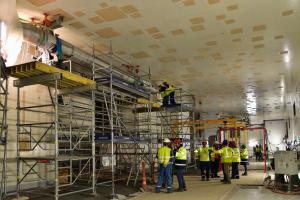Manufactured under Indian Domestic Agency contract partly in India and partly in France, the cryolines form a 2.7-kilometre network that circles the bioshield and connects to the feeders at the lower and upper levels of the machine.
In the lowest basement level of the Tokamak Building, the first cryoline sections, weighing 1 to 3 tonnes in average, are now in place. "We have to be very careful in positioning the sections, with tolerances that do not exceed few millimetres," says David Grillot, the head of ITER Cryogenic System Section.
Once a section is positioned, each individual pipe inside must be welded, as must the external jacket and its corresponding inner thermal shield.
Welded to the embedded plates in the gallery's ceiling, the supports holding the cryolines sections need to be particularly robust. Not only do they have to carry the full weight of the cryolines, but they must also withstand the forces that will be generated when the cryolines contract under the effect of intense cold—when liquid helium at minus 269° begins to flow inside the cryolines, a 10-metre pipe will shrink in length by 3 centimetres. Although flexible bellows will absorb part of the shrinking, the effort exerted on the supports will be in the range of a dozen tonnes.
There are some 50 cryoline sections to position and weld in the gallery at the basement level of the Tokamak Building. Once they reach "cruising speed," the teams expect to be able install three sections per week. There are approximately 500 sections to install throughout the entire building ...



